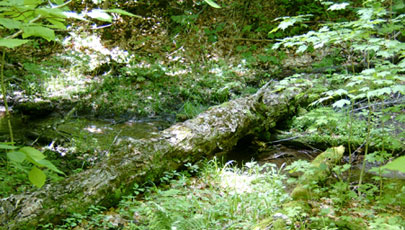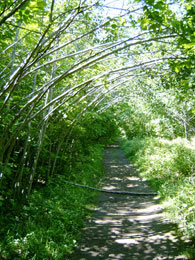Seeing the forest for the trees
Seeing the forest for the trees McGill University
User Tools (skip):

A mere moss-covered casualty to the untrained eye, a dead tree trunk is actually just as vital to forest equilibrium as a freshly planted sapling.
Michael Bourguignon
Seeing the forest for the trees
Nearly a decade after natural disaster, Gault Nature Reserve a study in rejuvenation
Like many Quebecers who witnessed the ice storm of January 1998, Martin Lechowicz recalls a surreal mix of devastation and unearthly beauty.

Overarching trees soak up some rays in a sunny spot along the Gault Nature Reserve's 25-kilometre trail network.
Michael Bourguignon
"With the ice on the trees, the blue sky, the snow on the ground, it was beautiful in a strange way," said Lechowicz, who, perhaps better than most, knew that there would be a silver lining to this particular cloud.
"What was also beautiful for me was the knowledge that the forest would recover and that I would get to watch and observe that over the next 10 years," said Lechowicz, director of the McGill-owned Gault Nature Reserve on Mont St. Hilaire on Montreal's south shore.
Though surprised by the magnitude of the storm, which left more than a million Quebec and Ontario homes and businesses without electricity for days or weeks on end, he viewed the event then, as he does now, as a tremendous opportunity to witness and learn from the power of nature in action.
The storm's devastating attack would bring public calls for human intervention, of course, but the future of the 1,000-hectare nature reserve—one of the only remnants of primeval forest in the St. Lawrence River Valley and the largest old-growth forest in the region—was left instead in the capable hands of Mother Nature. "We were under a lot of public pressure to clean up the forest, and we had to do a lot of outreach to explain why we didn't want to do that," he says. "Our question was: What will nature do if you leave nature alone?"
Although some new trees have since been planted along some of the 24 kilometres of trails, the reserve was pretty much left to heal its own wounds, which means the forest floor is still dotted—or, in some areas, blanketed—with dead or dying trees among the newer growth.
And that's just as it should be, according to Lechowicz, a professor in the Department of Biology. After all, one person's dead tree is actually a smorgasbord for a host of organisms that form an integral part of the forest ecosystem. As a hiker's guide to Mont St. Hilaire reminds visitors, "from young sapling to dead trunk, each phase of a tree's existence is crucial to forest equilibrium."
Indeed, almost a decade after the ice storm hit, the reserve (bequeathed to McGill in 1958 by Andrew Hamilton Gault on the condition that it be maintained for the education and enjoyment of future generations) has repaired itself better than any human intervention ever could.
"It's amazing to me to see how rejuvenated the forest is today," Lechowicz said. "When I drive up the mountain or walk the trails, it looks more and more the way it did 12 or 15 years ago. I could show you all kinds of data and numbers to prove it, but I think the visual impression is the strongest one."
For the McGill researchers who study the forest's impact on neighbouring waterways such as the Yamaska and Richelieu rivers, among other ongoing research projects, Mont St. Hilaire is a figurative goldmine. There are more than 600 higher plant species to study, more than 800 known species of butterflies and moths, some 370 known minerals—plus others that have yet to be identified—and innumerable new species to be discovered.
"We discover new species every year," said Lechowicz. "There is a whole set of insects living in the treetops that we didn't know about."
Left to her own devices, it seems Mother Nature will never fail to survive and surprise.

